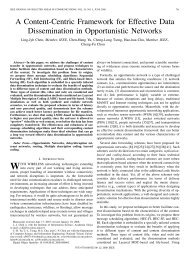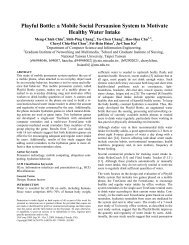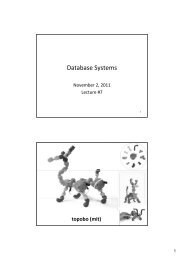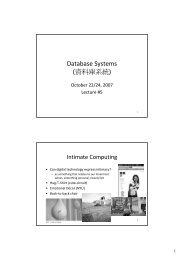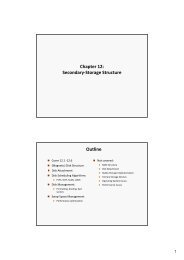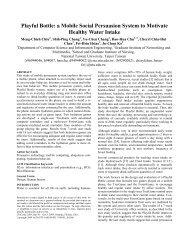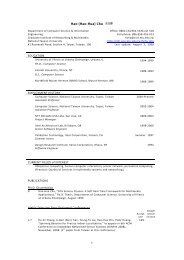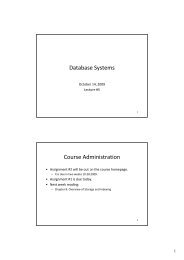D t b S t Database Systems (?????)
D t b S t Database Systems (?????)
D t b S t Database Systems (?????)
Create successful ePaper yourself
Turn your PDF publications into a flip-book with our unique Google optimized e-Paper software.
Dtb <strong>Database</strong> S<strong>Systems</strong> t<br />
(資料庫系統)<br />
November 30, 2011<br />
Lecture #10<br />
Admin<br />
• Assignment #4 Due midnight today<br />
• AAssignment i t#5 #5 out t on th the course hhomepage.<br />
1<br />
2<br />
1
Claytronics & Smart Digital Materials (CMU)<br />
Overview of Query Evaluation<br />
Chapter 12<br />
3<br />
4<br />
2
Review<br />
Applications<br />
Queries<br />
Query Optimization and Execution<br />
Relational Operators<br />
Files and Access Methods<br />
Buffer Manager<br />
Disk Space Manager<br />
Outline<br />
•Query evaluation (Overview)<br />
• Rlti Relational lOOperator t EEvaluation l ti Algorithms Al ith (O (Overview) i )<br />
• Statistics and Catalogs<br />
•Query Optimization (Overview)<br />
•Example<br />
5<br />
6<br />
3
Tables<br />
Sailors(sid, sname, rating, age)<br />
Reserves(sid, bid, day, rname)<br />
Overview of Query Evaluation (1)<br />
• What is Query Evaluation?<br />
• What is a good Query Evaluation?<br />
– Find an efficient plan (minimal disk I/Os)<br />
• How do you find a good plan?<br />
SELECT S.sname<br />
FROM Reserves R, R Sailors S<br />
WHERE R.sid=S.sid ^ R.bid=100 ^ S.rating>5<br />
7<br />
8<br />
4
Overview of Query Evaluation (II)<br />
• Step 1: a query is translated into a<br />
relational algebra tree<br />
– σ(selection), π (projection), and ∞ (join)<br />
SELECT S.sname<br />
FROM Reserves R, Sailors S<br />
WHERE R.sid=S.sid ^ R.bid=100 ^ S.rating>5<br />
π sname<br />
σ bid=100 ^ rating > 5<br />
∞ sid=sid<br />
RReserves Sailors<br />
Overview of Query Evaluation (III)<br />
• Step 2: Find a good evaluation<br />
plan (Query Optimization)<br />
π sname<br />
plan (Query Optimization) σ bid=100 ^ rating > 5<br />
– Estimate costs for several<br />
alternative equivalent evaluation<br />
plans.<br />
– How to estimate disk I/O cost?<br />
• access method & evaluation<br />
algorithm<br />
• statistics on table sizes, etc.<br />
– Different order of evaluations<br />
gives different cost.<br />
– How does it affect cost?<br />
• Push selection (bid=100) before<br />
join)<br />
∞ sid=sid<br />
Reserves Sailors<br />
π sname<br />
∞ sid=sid<br />
σ bid=100 σ rating > 5<br />
Reserves Sailors<br />
9<br />
10<br />
5
Overview of Query Evaluation (IV)<br />
• (continue step 2)<br />
– An evaluation plan is consisted of<br />
choosing access method &<br />
evaluation algorithm.<br />
π sname (on‐the‐fly)<br />
– Selecting an access method to<br />
retrieve records for each table on<br />
the tree (e.g., file scan, index<br />
search, etc.)<br />
σ bid=100 ^ rating > 5 (on‐the‐fly)<br />
– Selecting an evaluation algorithm<br />
for each relational operator on<br />
the tree (e.g., ( g , index nested loop p<br />
∞ sid=sid (index nested loop)<br />
join, sort‐merge join, etc.)<br />
Reserves Sailors<br />
(file scan) (file scan)<br />
Overview of Query Evaluation (V)<br />
•Two main issues in query optimization:<br />
– For a given query, query what plans are considered?<br />
• Consider a few plans (considering all is too many & expensive), and<br />
find the one with the cheapest (estimated) cost.<br />
– How is the cost of a plan estimated?<br />
– Consider:<br />
• Reserves ⋈ reserves.sid = sailors.sid Sailors (assume simple nested<br />
loop join)<br />
FForeach htuple l r iin<br />
reserves<br />
Foreach tuple s in sailors<br />
If (r.sid = s.sid) then add to the results<br />
• Sailors ⋈ (σ bid = 10 Reserves)<br />
• Sailors ⋈ (σ bid > 5 Reserves)<br />
11<br />
12<br />
6
Statistics and Catalogs<br />
• Examine catalog table that has data schemas and statistics.<br />
• NNeed di information f ti about b tth the relations lti and d iindexes d iinvolved. l d<br />
Catalogs typically contain at least:<br />
– # tuples (NTuples) and # pages (NPages) for each table.<br />
– # distinct key values (NKeys) and NPages for each index.<br />
– Index height, low/high key values (Low/High) for each tree index.<br />
• There are system‐wide factors that can also affect cost, such as<br />
size of buffer pool pool, buffer replacement algorithm algorithm.<br />
Statistics and Catalogs<br />
• Catalogs are updated periodically.<br />
– Updating whenever lots of data changes; lots of<br />
approximation anyway, so slight inconsistency is ok.<br />
•More detailed information (e.g., histograms of the<br />
values in some fields) are sometimes stored.<br />
–They can be used to estimate # tuples matching certain<br />
conditions (bid > 5)<br />
13<br />
14<br />
7
Relational Operator Evaluation<br />
• There are several alternative algorithms for implementing<br />
each relational operator (selection, projection, join, etc.).<br />
• No algorithm is always better (disk I/O costs) than the others.<br />
It depends on the following factors:<br />
– Sizes of tables involved<br />
– Existing indexes and sort orders<br />
– Size of buffer pool (Buffer replacement policy)<br />
• Describe (1) common techniques for relational operator<br />
algorithms, (2) access path, and (3) details of these algorithms.<br />
Some Common Techniques<br />
• Algorithms for evaluating relational operators use<br />
some simple ideas repeatedly:<br />
–Consider:σ bid = 10 Reserves<br />
• Indexing: If a selection or join condition is specified, use an<br />
index () to retrieve the tuples that satisfy the condition.<br />
–Consider: σ bid ≠ 10 Reserves, bid = 1 .. 1000<br />
• Iteration: Sometimes, faster to scan all tuples even if there is an<br />
index . Sometimes, scan the data entries in an index instead of<br />
the table itself. (π bid Reserves).<br />
–Consider: π sid, rname Reserves<br />
• Partitioning: By using sorting or hashing, partition the input<br />
tuples and replace an expensive operation by similar operations<br />
on smaller inputs<br />
15<br />
16<br />
8
Access Paths<br />
• An access path is a method of retrieving tuples.<br />
– Note that every relational operator takes one or two tables as its input.<br />
– There are two possible methods: (1) file scan, or (2) index that<br />
matches a selection condition.<br />
• Can we use an index for a selection condition? How does an<br />
index match a selection condition?<br />
– Selection condition can be rewritten into Conjunctive Normal Form<br />
(CNF), or a set of terms (conjuncts) connected by ^ (and).<br />
• Example Example: (rname=‘Joe’) (rname ‘Joe’) ^ (bid = 5) ^ (sid = 3)<br />
– Intuitively, an index matching conjuncts means that it can be used to<br />
retrieve (just) tuples that satisfy the conjunct.<br />
Access Paths for Tree Index<br />
• A tree index matches conjuncts that involve only attributes in a prefix of its<br />
index search key.<br />
– Eg E.g., Tree index on 6), but not (b=0).<br />
– Tree index on : , , , …, ,<br />
, …, …<br />
– Can match range condition (a>5 ^ b>3).<br />
• How about (a=5 ^ b=3 ^ c=2 ^ d=1)?<br />
– (a=5 ^ b=3 ^ c=2) is called primary conjuncts. Use index to get tuples satisfying<br />
primary p yconjuncts, j , then check the remaining g condition (d=1) ( ) for each retrieved<br />
tuple.<br />
• How about two indexes & ?<br />
– Many access paths: (1) use index, (2) use index, …<br />
– Pick the access path with the best selectivity (fewest page I/Os)<br />
17<br />
18<br />
9
Access Paths for Hash Index<br />
• A hash index matches a conjunct that has a term attribute =<br />
value for every attribute in the search key of the index.<br />
– E.g., Hash index on matches (a=5 ^ b=3 ^ c=5), but it does<br />
not match (b=3), (a=5 ^ b=3), or (a>5 ^ b=3 ^ c=5).<br />
• Compare to Tree Index:<br />
– Cannot match range condition.<br />
– Partial matching on primary conjuncts is ok.<br />
Selectivity of Access Paths<br />
• Selectivity of an access path is the number of page I/Os<br />
needed to retrieve the tuples satisfying the desired condition.<br />
• Why do we want to use the most selective access path (with<br />
the fewest page I/Os)?<br />
• What are the possible access paths for selections?<br />
– Use an index that matches the selection condition.<br />
– Scan the file records.<br />
– Scan the index (e.g., π bid Reserves, index on bid)<br />
• Access path using index may not be the most selective!<br />
– Why not?<br />
– Example: (σ bid ≠ 10 Reserves, unclustered index on bid).<br />
19<br />
20<br />
10
Selection<br />
SELECT (*)<br />
FROM Reserves R<br />
WHERE day
Reduction Factor & Catalog Stats<br />
• Reduction factor is the fraction of tuples in the table that<br />
satisfy a given conjunct.<br />
• Example #1:<br />
– Index H on Sailors with search key <br />
– Selection condition (bid=5)<br />
– Stats from Catalog: NKeys(H) = # of distinct key values = 10<br />
– Reduction factor = 1 / NKeys(H) = 1/10<br />
• Examples #2:<br />
– Index on Reserves 9/1/2002)<br />
– Index Key T on day<br />
– Stats from Catalog: High(T) = highest day value, Low(T) =<br />
lowest day value.<br />
– Reduction factor = (High(T) –value) / (High(T) – Low(T))<br />
– Say: y High(T) g ( ) = 12/31/2002, / / , Low(T) () =1/1/2002 / /<br />
– Reduction factor = 1/3<br />
23<br />
24<br />
12
Using an Index for Selections<br />
•Cost depends on #matched tuples and clustering.<br />
– Cost of finding qualifying data entries (typically small) plus<br />
cost of f retrieving records d ( (could ldbbe l large w/o / clustering) l )<br />
• Why large? Each matched entry could be on a different page.<br />
– Assume uniform distribution, 10% of tuples matched (100<br />
pages, 10,000 tuples).<br />
• With a clustered index on , cost is little more than 100 I/Os;<br />
• If unclustered, worse case is 10,000 I/Os.<br />
• Faster to do file scan => 1,000 I/Os<br />
SELECT *<br />
FROM Reserves R<br />
WHERE R.name = ‘John’<br />
Projection<br />
SELECT DISTINCT R.sid, R.bid<br />
FROM Reserves R<br />
•Projection drops columns not in the select attribute<br />
list.<br />
•The expensive part is removing duplicates.<br />
•If no duplicate removal,<br />
– Simple iteration through table.<br />
–Given index , scan the index entries.<br />
•If duplicate removal<br />
– use sorting (partitioning)<br />
(1) Scan table to obtain pairs<br />
(2) Sort pairs based on <br />
(3) Scan the sorted list to remove adjacent duplicates.<br />
25<br />
26<br />
13
More on Projection<br />
•Hash‐based projection:<br />
– HHash h on (#b (#buckets k t = #b #buffer ff pages). )<br />
–Load buckets into memory one at a time and eliminate<br />
duplicates.<br />
Join: Index Nested Loops<br />
foreach each r block in R do Reserves (R) ⋈ Sailors (S)<br />
foreach each s block in S where r.sid = s.sid do<br />
add dd < > tto result lt<br />
• There exists an index for Sailors.<br />
• Index Nested Loops: Scan R, for each tuple in R, then use index<br />
to find matching tuple in S.<br />
• Say we have unclustered static hash index in Sailors.<br />
What is the cost of join j operation? p<br />
– Scan R = 1000 I/Os<br />
– R has 100,000 tuples. For each R tuple, retrieve index page (1.2 I/Os on<br />
average for hashing) and data page (1 I/O).<br />
– Total cost = 1,000 + 100,000 *(1.2 + 1) = 221,000 I/Os.<br />
27<br />
28<br />
14
Join: Sort‐Merge<br />
•It does not use any index.<br />
• SSort tR R and d S on th the jjoin i column l<br />
•Scan sorted lists to find matches, like a merge on join<br />
column<br />
• Output resulting tuples.<br />
•More details about Sort‐Merge in Chapter 14.<br />
Example of Sort‐Merge Join<br />
sid sname rating age<br />
22 dustin 7 45.0<br />
28 yuppy 9 35.0<br />
28 lubber 8 55.5<br />
44 guppy 5 35.0<br />
58 rusty 10 35.0<br />
29<br />
sid bid day rname<br />
28 103 12/4/96 guppy<br />
28 103 11/3/96 yuppy<br />
31 101 10/10/96 dustin<br />
31 102 10/12/96 lubber<br />
31 101 10/11/96 lubber<br />
58 103 11/12/96 dustin<br />
• The cost of a merge sort is 2*M 2M log ( (B‐1) ) MM, whereas M = #pages #pages, B = size of<br />
buffer.<br />
– B‐1 is quite large, so log (B‐1) M is generally just 2.<br />
• Total cost = cost of sorting R & S + Cost of merging = 2*2*(1000+500) +<br />
(1000+500) = 7500 I/Os. (a lot less than index nested loops join!)<br />
30<br />
15
Index Nested Loop Join vs. Sort‐Merge<br />
Join<br />
Reserves (R) ⋈ Sailors (S)<br />
• Sort‐merge join does not require a pre‐existing index, and …<br />
– Performs better than index index‐nested nested loop join. join<br />
– Resulting tuples sorted on sid.<br />
• Index‐nested loop join has a nice property: incremental.<br />
– The cost proportional to the number of Reserves tuples.<br />
• Cost = #tuples(R) * Cost(accessing index+record)<br />
– Say we have very selective condition on Reserves tuples.<br />
• Additional selection: R.bid=101<br />
• Cost small for index nested loop, but large for sort‐merge join (sort Sailors &<br />
merging)<br />
– Example of considering the cost of a query (including the selection) as a<br />
whole, rather than just the join operation → query optimization.<br />
Other Relational Operators<br />
• Discussed simple evaluation algorithms for<br />
– Projection, Selection, and Join<br />
• How about other relational operators?<br />
– Set‐union, set‐intersection, set‐difference, etc.<br />
– The expensive part is duplicate elimination (same as in projection).<br />
– How to do R1 U R2 ?<br />
• SQL aggregation (group‐by, max, min, etc.)<br />
– Group‐by is typically implemented through sorting (without search<br />
index on group‐by attribute).<br />
– Aggregation operators are implemented using counters as tuples are<br />
retrieved.<br />
31<br />
32<br />
16
Query Optimization<br />
• Find a good plan for an entire query consisting of many<br />
relational operators.<br />
– So far, we have seen evaluation algorithms for each relational<br />
operator.<br />
• Query optimization has two basic steps:<br />
– Enumerate alternative plans for evaluating the query<br />
– Estimating the cost of each enumerated plan & choose the one with<br />
lowest estimated cost.<br />
• Consult the catalog for estimation.<br />
• Estimate size of result for each operation in tree (reduction factor).<br />
• More details on query optimization in Chapter 15.<br />
Motivating Example<br />
SELECT S.sname<br />
FROM Reserves R, Sailors S<br />
WHERE Rsid=Ssid R.sid=S.sid AND<br />
R.bid=100 AND S.rating>5<br />
• Cost: 1000+1000*500 I/Os<br />
• Misses several opportunities:<br />
selections could have been<br />
`pushed’ earlier, no use is made of<br />
any available indexes, etc.<br />
• Goal of optimization: To find<br />
more efficient plans that compute<br />
the same answer.<br />
Plan:<br />
RA Tree:<br />
σ bid=100 ^ rating > 5<br />
π sname<br />
∞ sid=sid<br />
33<br />
σ bid=100 ^ rating > 5<br />
Reserves Sailors<br />
π sname (on-the-fly)<br />
Reserves Sailors<br />
(file scan)<br />
(file scan)<br />
(on-the-fly)<br />
∞ sid=sid (block nested loop)<br />
34<br />
17
Pipeline Evaluation<br />
• How to avoid the cost of<br />
physically writing out<br />
iintermediate di results l bbetween<br />
π sname (on-the-fly) ( fy)<br />
operators?<br />
– Example: between join and<br />
selection<br />
σ bid=100 ^ rating > 5 (on-the-fly)<br />
– Use pipelining, each join tuple<br />
(produced by join) is (1) checked<br />
∞ sid=sid (simple nested loop)<br />
with selection condition, and (2)<br />
projected out on the fly, before<br />
being physically written out<br />
(materialized).<br />
Reserves<br />
(file scan)<br />
Sailors<br />
(file scan)<br />
Alternative Plan 1<br />
(No Indexes)<br />
• Main difference: push selects.<br />
• With 5 buffers, cost of plan:<br />
π sname<br />
(on-the-fly)<br />
π sid<br />
σ bid=100 bid 100<br />
∞ sid=sid (sort merge join)<br />
π sid, sname<br />
σ rating ti > 5<br />
Reserves Sailors<br />
(scan: write to temp) (scan: write to temp)<br />
– Scan Reserves (1000 pages) for selection + write temp T1 (10 pages, if we have<br />
100 boats, uniform distribution).<br />
– Scan Sailors (500 pages) for selection + write temp T2 (250 pages, if we have 10<br />
ratings, uniform distribution).<br />
– Sort T1 (2*2*10), ( ), sort T2 (2*4*250), ( ), merge g (10+250) ( )<br />
– Total: (1000 + 500 + 10 + 250) + (40 + 2000 + 260) = 4060 page I/Os.<br />
• If we used BNL join, join cost = 10+4*250, total cost = 2770.<br />
• If we `push’ projection, T1 has only sid, T2 only sid and sname:<br />
– T1 fits in 3 pages, cost of BNL drops to under 250 pages, total < 2000.<br />
35<br />
36<br />
18
Alternative Plan 2 With Indexes<br />
• With clustered index on bid of Reserves, we<br />
get 100,000/100 = 1000 tuples on 1000/100 =<br />
10 pages.<br />
• Use pipelining (the join tuples are not<br />
materialized).<br />
• Join column sid is a key for Sailors.<br />
• Projecting out unnecessary fields from Sailors<br />
may not help.<br />
(Use hash<br />
– Why not? Need Sailors.sid for join.<br />
index: do not<br />
write result to<br />
• Not to push rating>5 before the join because because,<br />
temp)<br />
– Want to use sid index on Sailors.<br />
• Cost: Selection of Reserves tuples (10 I/Os);<br />
for each,<br />
– Must get matching Sailors tuple (1000*1.2);<br />
total 1210 I/Os.<br />
•External sorting<br />
Next 2 Lectures<br />
• EEvaluation l ti of f relational lti loperators t<br />
•(Relational query optimizer)<br />
π sname (On-the-fly)<br />
σ rating > 5<br />
∞ sid=sid<br />
σ bid=100<br />
Reserves<br />
(Index Nested<br />
Loops, with<br />
pipelining )<br />
Sailors<br />
(On-the-fly)<br />
37<br />
38<br />
19
A Note on Complex Selections<br />
(day



